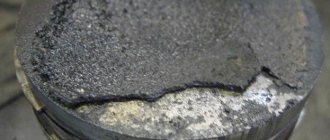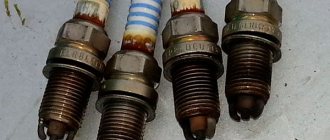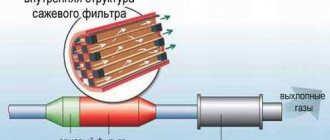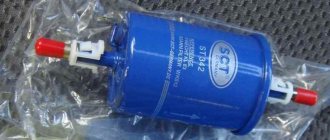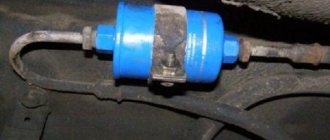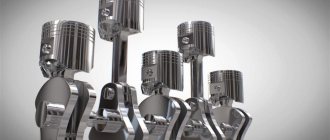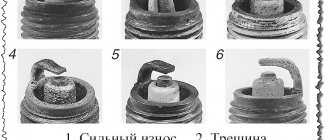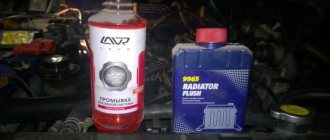The formation of soot and coke in a gasoline or diesel engine is a natural process that occurs in a closed combustion chamber of the fuel-air mixture.
Carbon deposits are essentially a layer of unburned deposits on the walls of the chamber. Over time, this layer becomes thicker and at a certain point can cause malfunctions of the power unit.
Let's look at the main signs and consequences of engine coking, as well as ways to clean it yourself without disassembling it.
Why is carbon deposits dangerous in an engine?
The carbon deposits formed in the engine significantly worsen its performance. This is due to the fact that:
- The carbon layer has poor thermal conductivity, so it impairs the removal of excess heat and the engine overheats.
- In turn, as a result of overheating, the motor power decreases, its other characteristics deteriorate, and its service life is reduced.
- Also, carbon deposits formed in the combustion chambers often cause detonation and glow ignition, which can result in serious engine damage.
What could be causing the deposit?
The main factors influencing the intensity of carbon deposits are:
- technical condition of the engine;
- quality and suitability of the motor oil and fuel used for the given engine;
- vehicle operating conditions.
For example, the use of low-grade fuel, with a high content of heavy fractions, can lead to the formation of a large amount of soot in a very short time. Which, if normal fuel was used, would take many years to form.
Methods for removing carbon deposits from an engine
1. In some cases, you can remove carbon deposits from the engine by filling the car with high-quality fuel and driving it at high speed for 10-15 km. This method does not always help and in this case you have to resort to more effective methods that also do not require disassembling the engine.
2. Carbon deposits are removed using a special solution that can be prepared:
- mixing 50% acetone;
- 25% kerosene;
- 25% motor oil.
The finished mixture must be poured through the hole for the candle into each cylinder, 100 ml. It is advisable that the engine be warm at this time and it is best if this carbon removal procedure is timed to coincide with a scheduled engine oil change.
First, even before pouring the solution, it is necessary to do some work to prepare the engine for cleaning. The purpose of this preparation is to prevent compression in the cylinders. How to achieve this depends on the design of the particular engine.
The simplest option is to install temporary metal plates between the valve stems and rocker arms, being careful not to disturb the valve adjustment. The plates should be about 0.8 - 1 mm thick and approximately 10 mm wide.
Having completed the preparation, you need to unscrew the candles and pour the prepared solution into the cylinders.
After this, the spark plugs are screwed back into place and the engine crankshaft is cranked 10 to 15 times using the starting handle. Or they crank the crankshaft by rotating the drive wheel hanging on a jack, while engaging the gear.
Then you need to remove the previously installed temporary plates.
The solution must be left in the cylinders for 10 - 15 hours, then unscrew the spark plugs and turn the crankshaft again, making about 10 revolutions.
- drain the engine oil;
- replace the oil filter;
- fill in new oil;
- Reinstall the cleaned spark plugs;
- start the engine.
After cleaning the engine, it is recommended to drive the car on a good road at high speed.
After a run of approximately 100 km, almost all of the carbon deposits will be removed. Do not forget that after driving 500 km you need to change the oil and oil filter in the engine again, as there will be a lot of dissolved impurities in the oil.
Cleaning throttle valves
PRO-LINE throttle valve cleaner is a special product for removing oil deposits and other contaminants from the intake system parts of gasoline engines.
The drug ensures the removal of impurities that cause jamming of the throttle valve and the mechanism for changing the length of the manifold. This allows you to eliminate the main causes of a drop in engine speed at idle and short-term loss of power directly when switching gears
In addition, the product also removes contaminants from the intake valves, which is especially important in engines with direct fuel injection. The procedure for cleaning the intake system and throttle valve with a wash is very simple:
- Remove the air supply hose from the throttle body and, using a long probe, pour the drug into the manifold, as well as directly onto the valve.
- After waiting for 3 minutes, you need to start the engine and set the rpm to 2500 rpm.
- Dispense the product into the manifold and onto the valve. To clean these elements you will need about 200 ml of the drug.
An innovative method of cleaning carbon deposits with hydrogen greatly simplifies the procedure. But it is used in specialized workshops, since a machine is needed to produce hydrogen. This premium device is available in the European market. Designed for engines with a volume of up to 20 thousand cubic centimeters. and forms a thick mixture of hydrogen up to 700 liters per hour.
The device non-contactly removes oil deposits from the engine in 90 minutes without changing the oil. Cleaning is recommended in particular for diesel engines that are used for short distances. The device itself is designed for any type of car. Cleaning procedure:
- open the air filter, connect the hydrogen supply tube to it;
- turn on the gas production machine;
- start the engine and set the appropriate crankshaft speed depending on the car model.
Useful video
Watch the video showing an effective means for removing carbon deposits in the combustion chamber:
And in this video, step-by-step instructions for decarbonizing an engine using kerosene and solvent:
A car with proper mileage and an unknown history... We drive, refuel, and don’t think about anything bad. A visit to the oiler, draining and filling, a mechanic’s conclusion - the oil immediately became dirty. It is not known whether this is due to the long service life of the engine or whether the lubricant replacement period has simply been missed... or is it of mediocre quality? Or maybe the work hasn’t completely merged. Definitely, there is no need to be upset - there is a way out.
Effect of compression ratio
When the compression ratio E changes, the quality of the working mixture's readiness for combustion changes. The compression ratio can be disrupted by incorrectly selected thickness of the gasket installed between the cylinder head and the block, when cutting the plane of the cylinder head or piston, changing the length of the connecting rod or the radius of the crank during the repair process.
An increase in the compression ratio compared to the optimal value is accompanied by an increase in engine operating rigidity and maximum combustion pressure.
A decrease in the E value slows down the combustion process and impairs operating efficiency.
We explain: how to flush a car engine from carbon deposits without disassembling it yourself
Symptoms
Before flushing the engine from carbon deposits inside, it is worth figuring out whether there is any at all. The presence of foreign inclusions in the combustion chamber is indicated by:
- difficult cold start;
- engine tripping;
- smoke from the exhaust pipe is blue or black;
- reduced compression;
- excessive consumption of fuel;
- detonation and overheating of the internal combustion engine at high speeds.
The presence of a problem is also indicated by the unclear response of the internal combustion engine to intensive throttling and polluted exhaust. In advanced cases, burning particles may fly out of the pipe. But this is only possible in the absence of a catalyst.
If such symptoms are detected, you definitely cannot hesitate. Exacerbation is fraught with the emergence of critical situations:
- valves coke;
- rings become dirty;
- ignition occurs not from a candle, but from smoldering burning (glow ignition).
Experienced mechanics recommend two-stage cleaning: removing carbon deposits and cleaning the oil system. However, with the latter, not everything is so simple.
Cleaning deep contaminants in the lubrication system
In extreme cases, thorough cleaning of the oil system is necessary. It is quite natural that it will not do without easy disassembly of the motor. In general, the procedure is divided into three episodes:
- Removing the pan and valve cover. Mechanical cleaning using aggressive chemicals and grinding tools.
- Reassembly and flushing of the power unit assembly with special oil or liquid added to regular lubricant.
- Removing the tray for manual cleaning again.
The pan is, first of all, a collection of all kinds of resinous dirt. What happens if you immediately pour detergent into an internal combustion engine with an unknown history, without cleaning the oil sump. Everything is obvious - the sludge will rise and clog the oil intake screen. A red oil can will light up on the instrument panel - the engine will operate in oil starvation conditions. You will have to disassemble everything and clean it manually.
Cleaning
The above actions, according to experts, apply only to seriously contaminated engines. If high-quality lubricant was used and its replacement interval was observed, then the technology for flushing the engine from carbon deposits without disassembling is quite applicable:
- Prepare the cleaning mixture.
- Remove the spark plugs.
- Align the pistons level with each other.
- Pour 50 cubes of detergent into each combustion chamber.
- Screw in the candles.
- Leave for 7-10 hours.
- Remove the mixture igniters.
- Add 25-50 ml of cleaning agent to each cylinder.
- Turn the engine with the starter.
- Put the candles back.
- Start the power plant.
- Fill the oil system with accelerated flushing for the time specified in the instructions.
- Turn off the engine.
- Change oil and filter.
Attention! Under no circumstances should you start an internal combustion engine with the combustion chamber filled with cleaning solution and spark plugs screwed in. There will be water hammer, and the engine will have to be overhauled. The described procedure can damage the catalyst.
Main signs of engine deposits
Carbon deposits and coke are the main products during the combustion of low-quality fuel. Under the influence of high temperature, when the amount of air is not enough to completely burn the fuel-air mixture, coke is formed. It settles in the form of dense deposits on the surface of the walls of the combustion chamber. Small particles separated from the coke form carbon deposits.
An important role in carbon formation is played by motor oil, which, if the tightness of the engine components (piston rings, valve seals) is insufficient, enters the combustion chamber. By burning with fuel, oil accelerates the process of deposit formation.
Carbon deposits in the engine lead to the following main malfunctions:
- problems with cold starting of the engine;
- when the engine is running, it smokes and runs unstable;
- exhaust gases mixed with burning;
- increased oil consumption;
- loss of power;
- increased fuel consumption;
- engine detonation and overheating at high speeds
Ignition delay period
During this period, a small portion of the fuel injected during the cycle enters the combustion chamber. During this period, the indicator diagram shows no noticeable changes in the flow of the compression line: the pressure in the cylinder continues to increase as if no fuel were entering it. As Qi increases, a lot of fuel accumulates in the combustion chamber at the time of ignition. This increases the operating rigidity of the diesel engine. The duration of the ignition delay period depends on the following main factors: fuel quality, fuel injection advance angle, pressure and temperature of compressed air at the start of fuel injection, injection start pressure, diesel load and crankshaft speed.
Let's consider the influence of each factor on the Qi value.
The chemical composition of diesel fuel greatly influences the Qi duration. The best diesel fuels are paraffin fuels, which have a higher cetane number and provide the shortest Qi duration and smooth diesel operation.
Each diesel design has its own fuel injection advance angle (FVP). Its optimal value depends on the load, thermal conditions, crankshaft speed, pressure and air temperature. As the FVP increases, the fuel injected into the combustion chamber enters a cold environment with low pressure, i.e., a lower volumetric concentration of oxygen. As a result, fuel ignition is delayed. Fuel accumulates in the cylinder, which burns before the piston reaches the top. This causes an increase in the rigidity of diesel operation and pressure Pz. With a low value of the FVP, the fuel does not burn completely, most of it burns during the expansion process (in the third phase), heat transfer into the cylinder walls increases, and the diesel power decreases.
An increase in the pressure and temperature of the compressed air at the start of injection contributes to earlier self-ignition of the fuel, a reduction in the ignition delay period, and smoother engine operation.
An increase in injection start pressure leads to an additional delay in the start of injection and the injection duration is reduced. When the injection start pressure decreases, the quality of fuel atomization and mixture formation deteriorates, which leads to a deterioration in the working process.
An increase in load is accompanied by a greater fuel supply per cycle, and the conditions for preparing the working mixture for combustion are improved. Consequently, the duration of Qi decreases with increasing load.
The crankshaft rotation speed n affects the value of Qi in the following way. When n changes, the FVP, pressure and duration of fuel injection, and the quality of its atomization change. The pressure and temperature of the air in the compression chamber also changes by the time injection begins. On high-speed diesel engines intended for operation with frequently changing speed conditions, devices are installed that ensure automatic change in the value of the FVP when n changes.
From the above it is clear that the moment of injection start and the ignition delay period have a great influence on the combustion process, on the power and efficiency of diesel engines. Therefore, during their operation, these indicators must be maintained within specified limits.
The average rate of pressure rise in section 2...3 determines the severity of the diesel engine. It is considered non-rigid if the average rate of pressure increase delta_P/delta_f does not exceed 0.5 MPa per 1° crankshaft rotation angle.
The more fuel enters the cylinder during the ignition delay period Qi, the harsher the engine operation and the greater the maximum combustion pressure Pz reaches.
The nature of fuel supply is determined by the cam profile, the diameter and stroke of the fuel pump plunger, the design of the diesel engine and the quality of the fuel. For example, the use of gasoline instead of diesel fuel causes the appearance of shock waves and pressure vibration in the diesel cylinder.
Possible consequences of carbon deposits in the engine
It not only reduces operating efficiency, deteriorates overall performance, leads to high consumption of fuels and lubricants, but also increases the risk of serious engine damage and, as a result, expensive repairs. Main possible examples of such consequences:
- Formation of carbon deposits on the valves - the valve cannot close completely.
- deposits on the rings - rings become stuck.
- potassium ignition effect - uncontrolled ignition of the mixture from smoldering.
Carbon deposits and coke are the main ways to get rid of them from an engine
There are two main options that can be used to clean the motor, let's look at each of them:
- clean the power unit with any flushing agent;
- disassemble the engine and mechanically remove deposits
As for flushing oils and fuel additives, this cleaning will remove small deposits in the fuel system, lubrication system, combustion chamber and other places only if the contamination is insignificant. Otherwise, in case of heavy contamination, such additives will not wash away the deposits and the cleaning effect will not be achieved. Sometimes you can even make the situation worse and cause harm.
Many motorists are interested in the question of how to flush the engine from carbon deposits without disassembling it? Therefore, we will consider a method in which the unit does not need to be disassembled.
- We unscrew the spark plugs on gasoline cars, or potassium plugs on diesel cars.
- We pour a special “decarbonization” liquid into the cylinders through the spark plug wells.
- We wait several hours - the cleaner softens the deposits.
- We screw in the spark plugs and start the engine. The softened carbon burns out and is removed from the cylinders.
After this procedure, you cannot use the oil and oil filter remaining in the engine; they must be replaced. Getting into the engine crankcase, the washed composition saturates the oil and filter with abrasive particles that are aggressive towards the cylinders.
To achieve the maximum effect of engine cleanliness, it is necessary to use a mechanical cleaning method. Its principle is simple - the motor is disassembled and cleaned of carbon deposits and coke manually using an abrasive tool. Then it is washed with detergents with high surface activity. This method allows you to clean all hard-to-reach engine elements, including lubricant supply channels and other elements.
Ecology and automobile
The population should take care of the environment at different levels: do not burn waste, sort garbage, drive cars that meet the standards. Therefore, car owners should check the exhaust of their car with a gas analyzer.
Currently, one of the most dangerous threats is the exhaust gases coming from cars. If you imagine the amount emitted by each car around the world, you can conclude that the level of pollution on Earth is growing at an alarming rate.
To counteract this situation and help the earth's atmosphere, scientists and automobile factories are increasingly introducing models of environmentally friendly cars. Cars are created taking into account environmental protection and the reduction of harmful exhaust gases, which avoids carbon dioxide emissions into the atmosphere. There are different types of green cars: solar, hydrogen, biofuel and electric.
The biggest controversy concerns the setting of restrictions. Since 2012, all cars sold in the EU emit an average of 120g of carbon dioxide for every kilometer driven.
Source
Advantages of engine cleaning without disassembly
Obviously, the main advantage is the absence of the need to disassemble the power unit. Mechanical disassembly is a complex and time-consuming process that requires an impressive amount of work. Carrying it out just for the sake of removing carbon deposits is impractical. This procedure is typical when performing major engine repairs.
It is worth noting that before performing the cleaning procedure, you should seek advice from professional mechanics. A completely cleaned engine is beyond the power of even very strong chemicals, and its incorrect use can cause damage.
The most common risk is blockage of the channels by particles separated from carbon deposits. Sometimes, in such a development of events, it is better not to touch the engine - this will allow it to be used for some more time. Otherwise, when you try to wash it, the likelihood of subsequent repairs is very high.
Precautionary measures
To clean the engine, many car owners use folk remedies. When using such means, you must carefully ensure that the electrical part of the equipment does not fail.
When using household chemicals, you must wear a mask and gloves to protect your respiratory system and hands. You will also need goggles, arm guards and work clothes. When using splashing drugs, do not allow them to come into contact with bare skin or eyes.
Do not remove the mask until the chemical under the hood has dried if you continue to wash the engine. Do not allow corrosive substances to come into contact with the battery, otherwise you will lose it.
Similar article Adding oil to a hot and cold engine
As you can see, it is easy to wash the engine, but only by protecting yourself from emergency situations. Now let's move on to the washing procedure itself.
